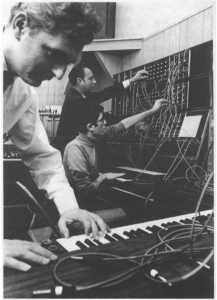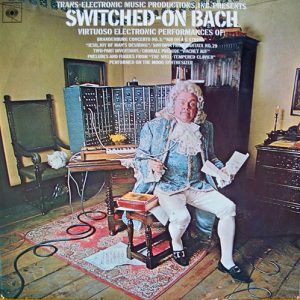The Moog synthesizer did not grow in popularity until the keyboard became a standard module in the unit. By linking an already familiar instrument to a new and unfamiliar technology, Moog managed to draw more positive attention to his space-sound-making machine. One of the first advertisements for the synthesizer features Moog and two other men playing the synthesizer, with one hand on the keyboard and one reaching to turn a dial (Pinch and Trocco 16). By visually linking the “machine” part of the synthesizer to the musically-associated keyboard, Moog managed to bring technology and music together for his clients.
Early advertisement for the R.A. Moog Company
One of the best-selling classical records of all time is Wendy Carlos’ Switched on Bach (1968), a collection of Bach’s music recorded on the Moog (Porcaro). This combination of familiar classical music with the new sound of the synthesizer catalyzed the Moog’s popularity. Again, visuals played a huge part in the link between the technological and the musical, as the cover art depicts a man dressed as Bach composing his music with a Moog synthesizer. (Pinch and Trocco 20)
After this album’s rise in popularity, Moog ended up on TV, in The New York Times, and in Time magazine showing off his synthesizer (Pinch and Trocco 21). With the link between new technology and familiar music cemented in the minds of customers, so too was the Moog’s popularity established.


